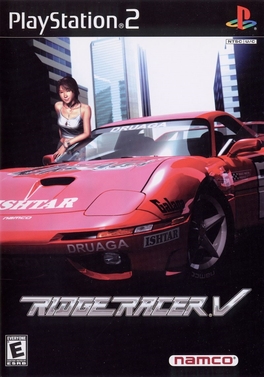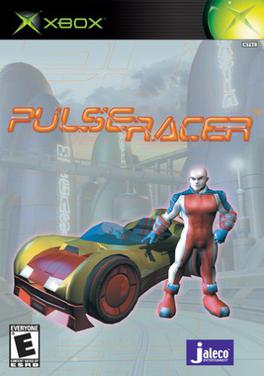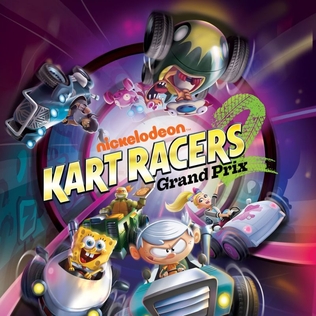Need for Speed (NFS) is a racing game franchise published by Electronic Arts and currently developed by Criterion Games. The series generally centers around illegal street racing, and tasks players to complete various types of races while evading the local law enforcement in police pursuits. Need for Speed is one of EA's oldest franchises not published under their EA Sports brand.
Ridge Racer is a series of racing video games created by Namco and owned by Bandai Namco Entertainment. The first game, Ridge Racer (1993), was originally released in arcades for the Namco System 22 hardware, later ported to the PlayStation one year later as a launch title. It was met with several sequels and spin-off games for multiple platforms, the latest being the mobile game Ridge Racer Draw & Drift (2016) and the latest mainline game, developed in-house, was Ridge Racer 7 (2006). Gameplay involves the player racing against computer-controlled opponents to be the first to finish in a race. Drifting is a core aspect of the series and is used to keep speed while turning corners; Ridge Racer pioneered the real-life technique in video games. The series is considered influential to the racing game genre.

Need for Speed: Underground is a 2003 racing video game and the seventh installment in the Need for Speed series following Hot Pursuit 2 (2002). It was developed by EA Black Box and published by Electronic Arts. Three different versions of the game were produced: one for consoles and Microsoft Windows, and another for the Game Boy Advance. An arcade version developed by Global VR and co-published by Konami came out two years later.

Midnight Club 3: Dub Edition is a 2005 racing video game developed by Rockstar San Diego and published by Rockstar Games. It is the third installment in the Midnight Club series. Like previous installments in the series, the game is an arcade-style racer and focuses on wild, high-speed racing, rather than realistic physics and driving. The name is derived from a partnership between Rockstar and DUB Magazine, which features heavily in the game in the form of DUB-sponsored races and DUB-customized vehicles as prizes.

Ridge Racer Revolution is a racing video game developed and published by Namco for the PlayStation. It is the sequel to the PlayStation version of Ridge Racer. Like the original Ridge Racer, the player races computer-controlled cars with the objective of winning a series of races, and supports Namco's NeGcon controller. Ridge Racer Revolution adds two hidden cars, and two-player support via the PlayStation Link cable, and took roughly the same time to develop as the first. The intention was to increase the depth and add features.

Ridge Racer V is a 2000 racing video game developed and published by Namco for the PlayStation 2. It was released as a launch title for the console and later followed by an arcade version subtitled Arcade Battle. Ridge Racer V is the fifth main title of the Ridge Racer series following R4: Ridge Racer Type 4 and the only one to be released on PlayStation 2.

Ridge Racer 6 is a racing video game developed and published by Namco for the Xbox 360. It is an installment in the Ridge Racer series. Unlike the previous mainline entries, which were released for either PlayStation or Nintendo consoles, this entry was released exclusively as a launch title for the Xbox 360 in 2005, marking the series' debut on Xbox consoles. Electronic Arts distributed physical copies of the game in Europe in 2006 while Namco released the game on Xbox Marketplace in the region.

Ridge Racer 7 is a 2006 racing video game developed and published by Namco Bandai Games for the PlayStation 3. An installment in the Ridge Racer series, it is an enhanced version of Xbox 360 exclusive Ridge Racer 6 with more content, releasing as a launch title for the console

Ridge Racer, released in Japan as Ridge Racers, is a 2004 racing video game developed and published by Namco for the PlayStation Portable. An installment in the Ridge Racer series, it was released as a global launch title for the system, on 12 December 2004 in Japan and overseas in 2005. Ridge Racer has been described as a 'compilation' of the series, featuring tracks, cars and remixed soundtrack from previous titles of the 1990s. Gameplay-wise, it marked the change from the "classic" style last seen in Ridge Racer V to the new drifting mechanic and nitrous boost that the series would incorporate from there on, including on Ridge Racer 6 and Ridge Racer 7.

Need for Speed: Carbon is a 2006 racing video game and the tenth installment in the Need for Speed series. Developed by EA Black Box, Rovio Mobile and published by Electronic Arts, it was released on October 31, 2006, for the PlayStation 2, PlayStation 3, Xbox, Xbox 360, GameCube, Windows, and Mac OS X, and on November 19, 2006 as a launch title for the Wii and in 2008 for arcade cabinets. A portable version, Need for Speed: Carbon – Own the City, was released for the PlayStation Portable, Game Boy Advance, Nintendo DS. and Zeebo, While it featured similar gameplay to the console version, the portable versions included new or modified gameplay elements, a different setting and storyline, and a different selection of teammates. This is the final installment in the series to be released for Game Boy Advance.

Ridge Racer is a 1993 racing video game developed and published by Namco for arcades. It is the first installment in Namco's Ridge Racer series. It was released initially on the Namco System 22 arcade system board and ported to the PlayStation home console in 1994. Ridge Racer was notable for being the first arcade video game with 3D texture-mapped graphics, with its System 22 hardware capable of texture mapping and Gouraud shading.

Road Trip: The Arcade Edition, known as Gadget Racers in Europe and Choro Q! in Japan, is a racing video game released in 2002 by Takara. It is based mainly upon Road Trip Adventure, a predecessor, however was only sold for the GameCube. Allowing this, weapons were added to a more racing perspective to make it an arcade version. It involves toy cars known in as Choro-Q or Penny Racers.

Ridge Racer 2, released in Japan as Ridge Racers 2, is a 2006 racing video game developed and published by Namco Bandai Games for the PlayStation Portable. It is the twelfth main installment in the Ridge Racer series. It is a sequel to Ridge Racer, which was released as a launch title for the console. It adds more extra content with additional tracks recycled from older titles of the series, as well as two new game modes called Duel and Survival.

Ridge Racer 3D is a 2011 racing video game developed and published by Namco Bandai Games for the Nintendo 3DS. It is the first Ridge Racer series title on a Nintendo platform since Ridge Racer DS (2004) and as usual for the series revolves around cars racing around high speed tracks while drifting. The game received positive reviews and was a commercial success.

Pulse Racer is a video game developed and published by Jaleco Entertainment in North America for the Xbox in 2002. The game is a futuristic racing game featuring the addition of a speed boost system in which players "use their own life force" to gain acceleration in races. Pulse Racer also featured a novel track creation system, INFINITRAX, in which players could generate random tracks by setting a number of custom parameters. The game was released to a poor critical reception, with reviewers faulting the game's unoriginality and lackluster execution of its novel gameplay additions, including the speed boost system. The game remains one of the lowest-rated titles for the Xbox.

DrawRace 2 is a racing video game developed by Ubisoft RedLynx and published by EA Chillingo. It was released September 1, 2011 for iOS devices, and serves as the sequel to DrawRace. It is played by drawing an ideal racing line on the game's screen with a finger. The car then follows this line during a race. The game was well received by critics, and holds a four stars rating and an average score of 88/100 at review aggregator Metacritic.

Need for Speed: Most Wanted is a 2005 racing video game, and the ninth installment in the Need for Speed series following Underground 2. Developed and published by Electronic Arts (EA), it was released in November 2005 for GameCube, PlayStation 2, Windows, Xbox, and Xbox 360 alongside two distinct versions for Nintendo DS and Game Boy Advance. Another version for PlayStation Portable titled Need for Speed: Most Wanted 5-1-0, was released at the same time and featured alternative gameplay.

Asphalt 8: Airborne is a 2013 racing video game developed by Gameloft Barcelona and published by Gameloft. It is the tenth major game of the Asphalt series. It was released on August 22, 2013, for iOS and Android, November 13 for Windows 8 and Windows Phone 8, January 15, 2014 for BlackBerry 10, and April 5, 2015 for Tizen. Its successor, Asphalt Legends Unite, was announced on February 26, 2018. The game has about 470 million players, according to the game description in the App Store.

Hot Wheels Ultimate Racing is a 2007 racing video game developed by Italian company Raylight Studios and published by DSI Games for the PlayStation Portable (PSP) exclusively. The game is based on the Hot Wheels toy line which manufactured by Mattel.

Nickelodeon Kart Racers 2: Grand Prix is a racing game developed by Bamtang Games and published by GameMill Entertainment in North America, Maximum Games in Europe, and Ripples Asia Venture in Japan. A sequel to 2018's Nickelodeon Kart Racers, it was released for Nintendo Switch, PlayStation 4, and Xbox One on October 6, 2020, and for Windows on December 1, 2020. Mobile versions for Android and iOS were later released on February 24, 2022. A sequel, titled Nickelodeon Kart Racers 3: Slime Speedway, was released in October 2022.



















